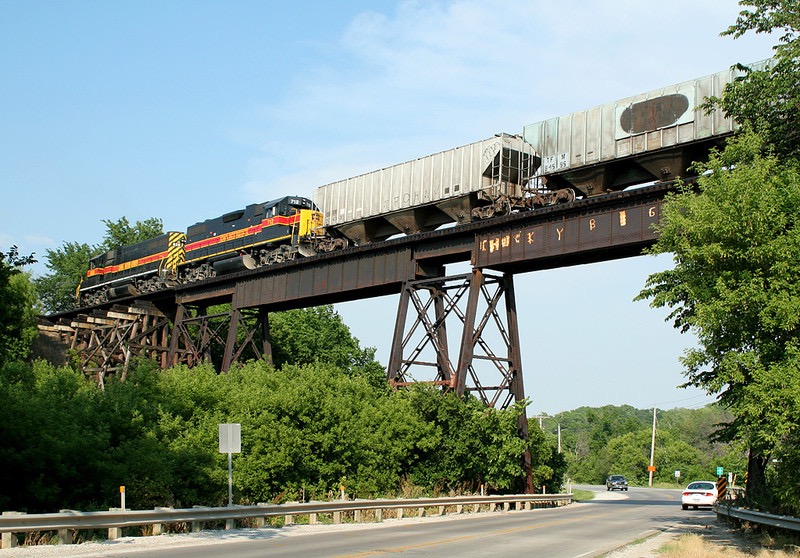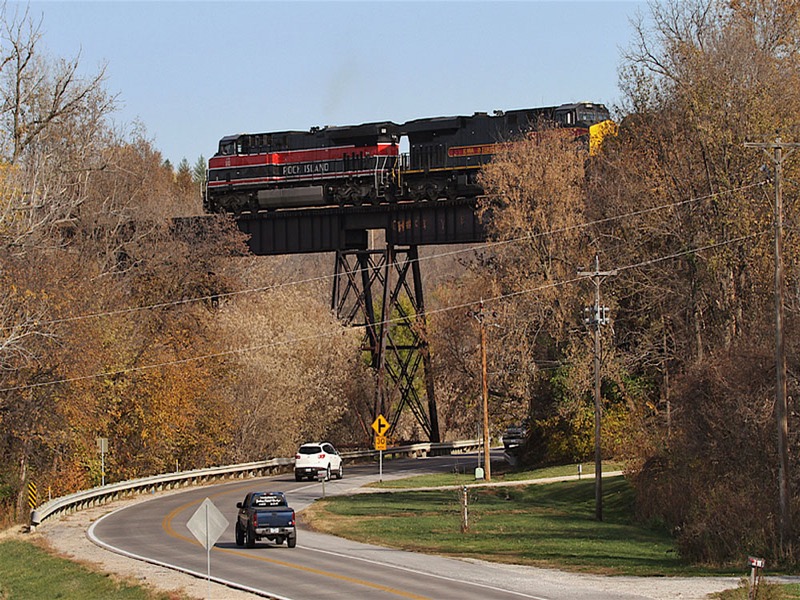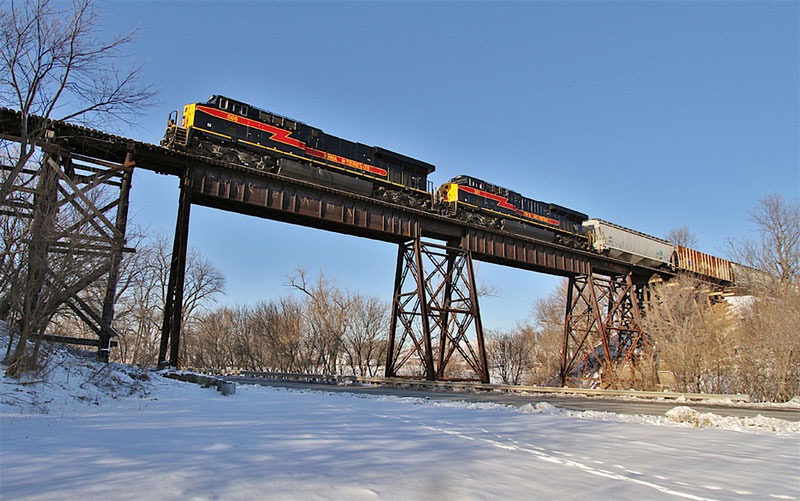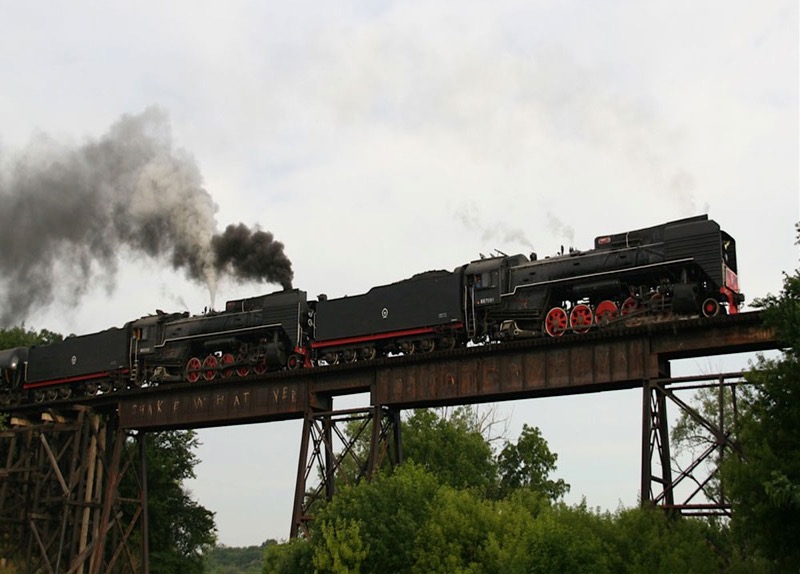Convention Day 1 - Room Sale Gems
Jun 30, 2016
The N-Scale National Convention kicked off today in Kansas City. The Mighty MKT was on the layout bus tours all day. I spent the time between bus arrivals to restage the layout from the great LanaRail op session that we had on Monday. I have another session Thursday afternoon (ReddeRail), so I was glad to complete the staging process.
Anyway, Joe and I attended the welcome banquet that kicks off the convention. After the banquet/meeting was over, we wandered through several hotel rooms, with vendors and individuals were selling N-scale items.
I picked up a few nice pieces:
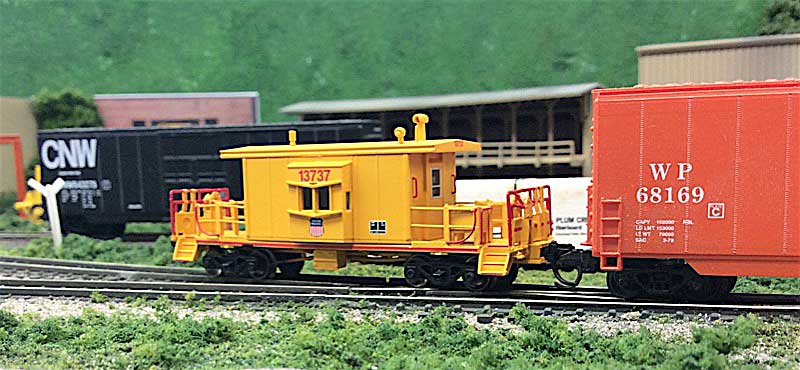
This UP transfer caboose has already found a place on the rear of the a.m. shift of the UP Boonville Job
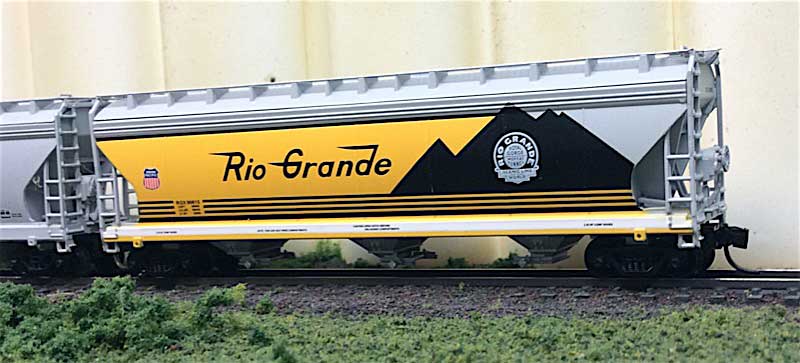
This Rio Grande covered hopper is now in service at Cargill on the UP side in Boonville
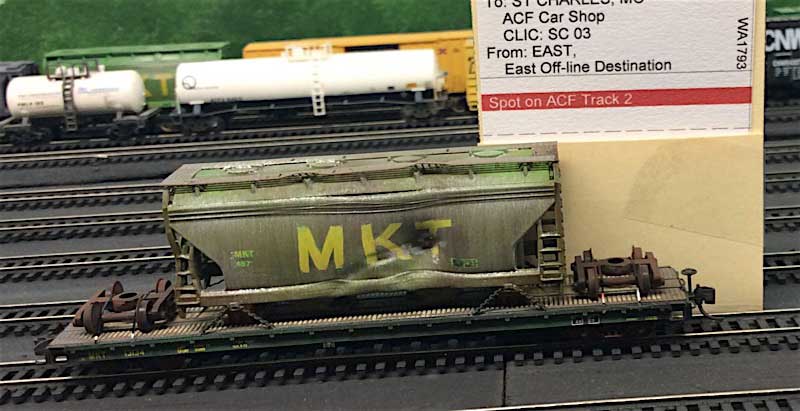
There was a fellow (Charles Hopkins) selling awesome open loads, and I couldn't resist this damaged covered hopper flat car load. It is currently in Franklin Yard, awaiting the next St. Charles local, where it will be sent to the ACF car repair facility in St. Charles.
Anyway, Joe and I attended the welcome banquet that kicks off the convention. After the banquet/meeting was over, we wandered through several hotel rooms, with vendors and individuals were selling N-scale items.
I picked up a few nice pieces:

This UP transfer caboose has already found a place on the rear of the a.m. shift of the UP Boonville Job

This Rio Grande covered hopper is now in service at Cargill on the UP side in Boonville

There was a fellow (Charles Hopkins) selling awesome open loads, and I couldn't resist this damaged covered hopper flat car load. It is currently in Franklin Yard, awaiting the next St. Charles local, where it will be sent to the ACF car repair facility in St. Charles.
What they don't tell you when you start building a layout
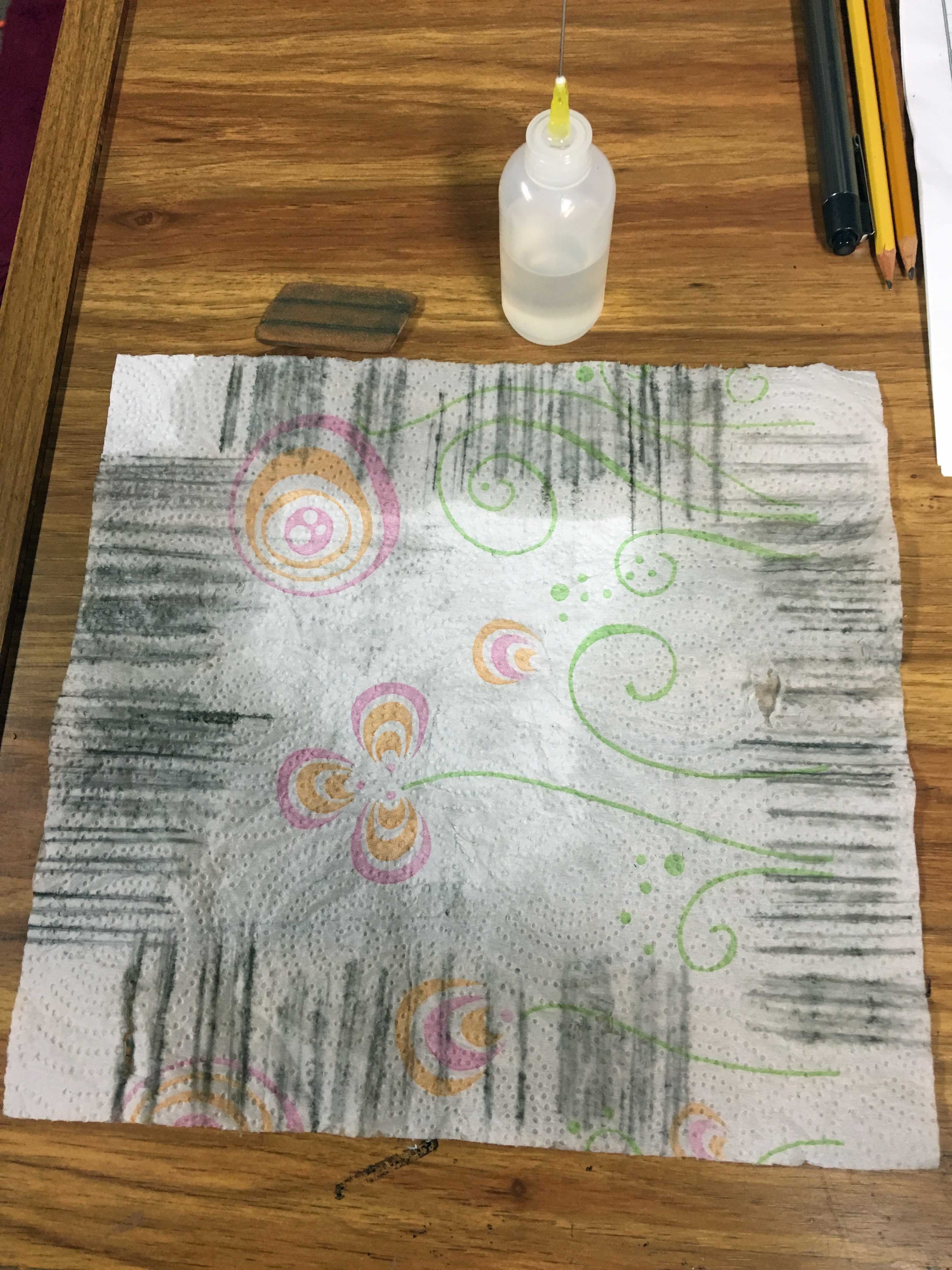
If you are the owner of a layout intended for operations, I don't have to tell you what this is.
Presented without comment
Jun 25, 2016
T minus 3 days and counting
Jun 25, 2016
The National N-Scale Convention is next week, and the Mightly MKT will be a busy layout indeed that week.
We kick off the week with an operating session for the Denver Group (plus an Aussie and a Washingtonian) on Monday. We'll be on the layout tour all day Wednesday and Thursday morning, and have another operating session Thursday at noon.
I also have helper duties at Joe's fabulous BN layout Tuesday night and Thursday night. So I'll be a busy bee.
It's all good, though, and I am really looking forward to the Convention, especially the trade show. I hope to be able to keep my credit card in my pocket, but I suspect that it will be a hopeless cause!
At the moment, I'm in the final throes of prepping and staging for the operating session. And cleaning track, the bane of a sceniced N-scale layout. Thank goodness I have the weekend, and I should be in pretty good shape by Monday night.
I'll post pictures of the Convention and the op sessions, so check back for updates!
We kick off the week with an operating session for the Denver Group (plus an Aussie and a Washingtonian) on Monday. We'll be on the layout tour all day Wednesday and Thursday morning, and have another operating session Thursday at noon.
I also have helper duties at Joe's fabulous BN layout Tuesday night and Thursday night. So I'll be a busy bee.
It's all good, though, and I am really looking forward to the Convention, especially the trade show. I hope to be able to keep my credit card in my pocket, but I suspect that it will be a hopeless cause!
At the moment, I'm in the final throes of prepping and staging for the operating session. And cleaning track, the bane of a sceniced N-scale layout. Thank goodness I have the weekend, and I should be in pretty good shape by Monday night.
I'll post pictures of the Convention and the op sessions, so check back for updates!
Seven days and counting...
Jun 20, 2016

Eek!
Only seven days until the N-Scale Collectors Convention descends on the Kanas City area.
I have a busy week coming up – the layout will be on tour several days and I have scheduled two operating sessions during the week. The first session is in seven days.
So of course, I’m in a panic, working on last-minute projects and cleaning everything. Since I’ve recently painted and ballasted lots of track (and don’t forget the yummy new Kasper MKVII, Rev 2 turnouts in St. Charles and East Rhineland), I need to clean all the track on the layout, because the paint overspray tends to get everywhere. Every mainline, siding, staging, and industry track is cleaned and inspected.
Cleaning track is not difficult, it’s just time consuming, and it’s easy to miss a track. After cleaning, I try to run a locomotive over every piece of track, just to check the turnout operation and smooth running.
In my opinion, the death knell to operating enjoyment is crappy running locomotives. Clean track is important to good running, and in N-scale (and DCC in particular) it is crucial. I’m so jealous of the HO guys, with their heavier locos, and wider wheel treads, and more forgiving turnouts, and the new awesome DCC current keepers. We N-scalers need to always go the extra mile to get the layout running smoothly.
I have a week to go, and the layout is in pretty good shape, all things considered. So if you are attending the N-Scale Collectors Convention next week, please stop by and say hi. I’ll be the nervous-looking guy over in the corning, mumbling to himself.
Bonus Elite Operator™ tip: Don’t build a layout bigger than you are willing to maintain.
Lights arrive at Columbia!!
Jun 19, 2016 Filed in: Scenery
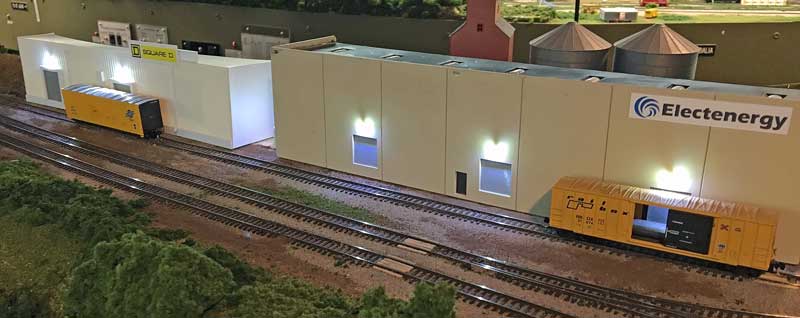
I spent the day in the Layout room, cleaning track and doing some projects that have been lingering on the to-do list. This includes installing LED lights on the tip-up industrial buildings at Columbia, Square D and Electenergy. I used the same copper foil bus techniques that I described earlier. I used 1K resistors, so the light are not quite as bright at the ACF lights over in St. Charles.
This was an easy project, but the effect is really nice.
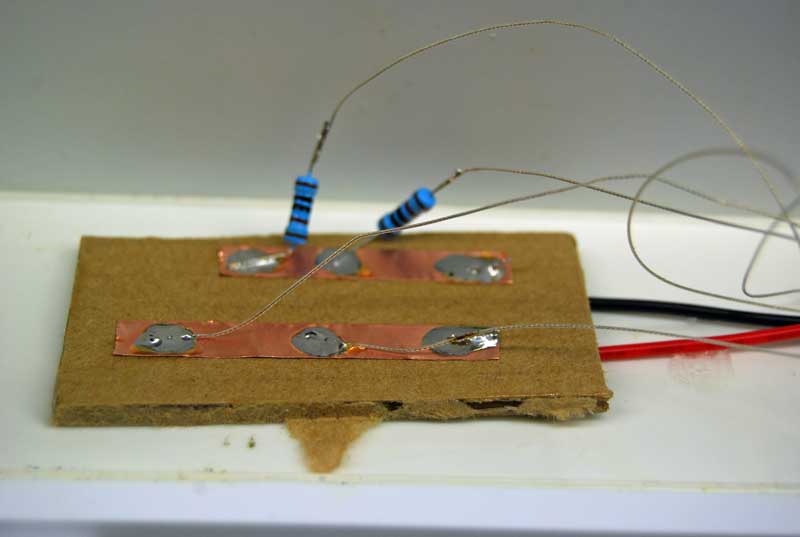
Closeup of the copper foil electrical bus. A wiring harness is soldered to each bus, keeping the wire color orientation the same. I use the standard DC wire color of red for +Voltage and black for ground.
Progress at St. Charles
I'm wrapping up St. Charles for now, so I can concentrate on cleaning track.
Here are a few progress shots. I still have some ballasting, ground cover, and background work to do, but wanted to share these pics.
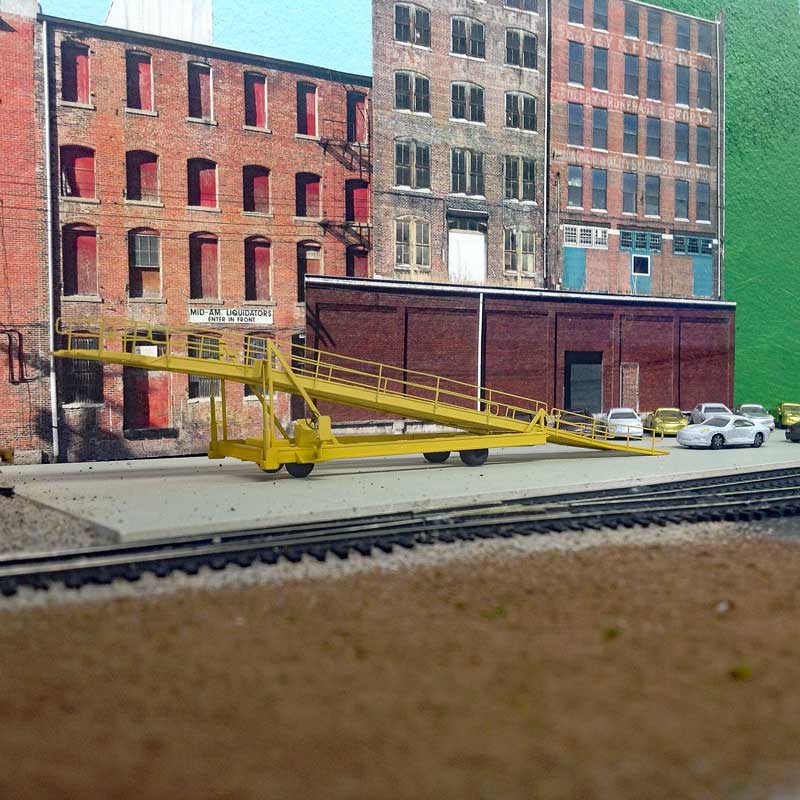
Auto loader at the Hazelwood Autoramp

Cars awaiting loading at Hazelwood. The NS interchange tracks are to the right.

Latest iteration of the staging hole hiding project

Trailer awaiting loading at the St. Charles Pig Ramp
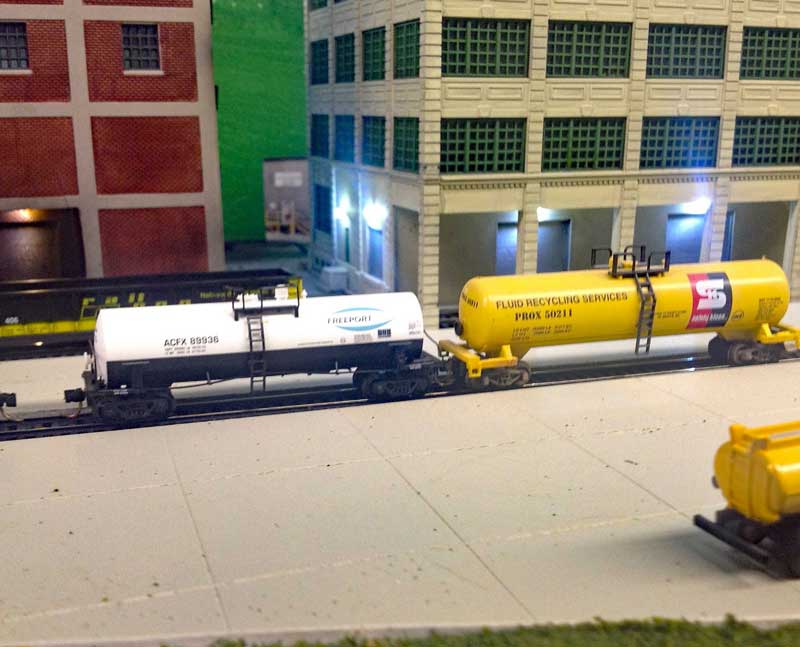
Tanks at Safety Kleen.
Here are a few progress shots. I still have some ballasting, ground cover, and background work to do, but wanted to share these pics.

Auto loader at the Hazelwood Autoramp

Cars awaiting loading at Hazelwood. The NS interchange tracks are to the right.

Latest iteration of the staging hole hiding project

Trailer awaiting loading at the St. Charles Pig Ramp

Tanks at Safety Kleen.
Let there be (LED) light!
The last few days have been busy with some final projects before I start cleaning the layout in preparation for the N-scale Convention tours and operating sessions.
I wanted to add some lighting the ACF Car Repair buildings at East St. Charles.
The lights turned out great and I wanted to share my method for installing the LEDs. It's not rocket science, but you may find a tip or two here.
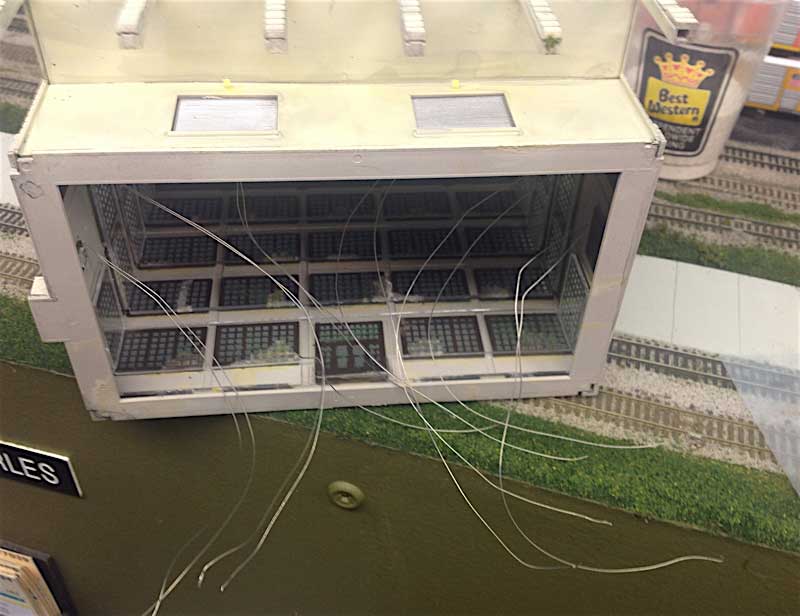
Step 1 - buy the pre-wired LEDs off eBay (free shipping from China!) and install in the buildings. I just drill a small hole at the location, thread the wires in and secure in place with a tiny dab of super glue. A quick shot of CA accelerator, and the LED is secure.
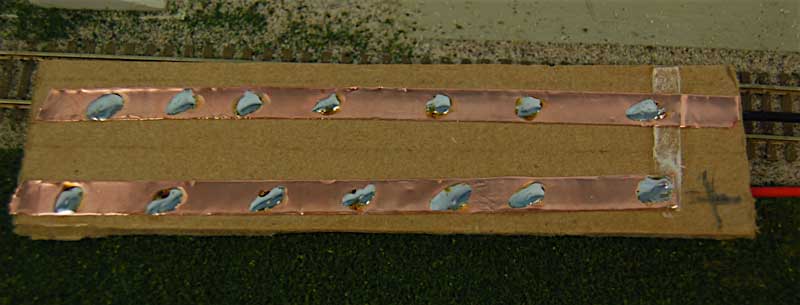
Step 2 - I make an electrical bus with copper strips that are used for stained glass windows. It has an adhesive backing and takes solder REALLY well. I also use wiring connector plugs (from eBay) that allow me to building these things at the work bench, then plug them into a 12 volt supply from under the layout. Both the positive bus and the ground bus are tinned where I will land the resistors and the wires.
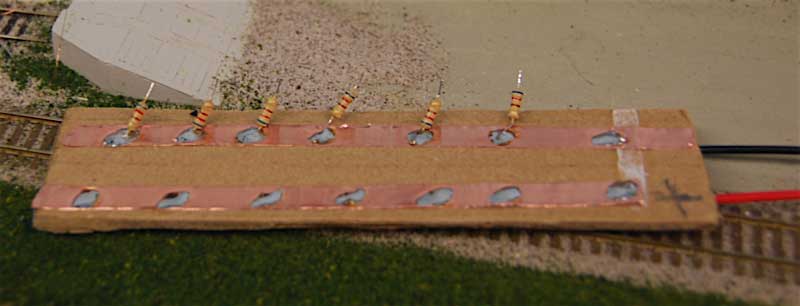
Step 3 - I trim the leads from the resistors and solder into place. The resistor leads going to the bus don't need to be tinned, but I tin the free ends, because it makes the next step a LOT easier. The resistors values have been selected to provide good intensity with a 12 volt supply.
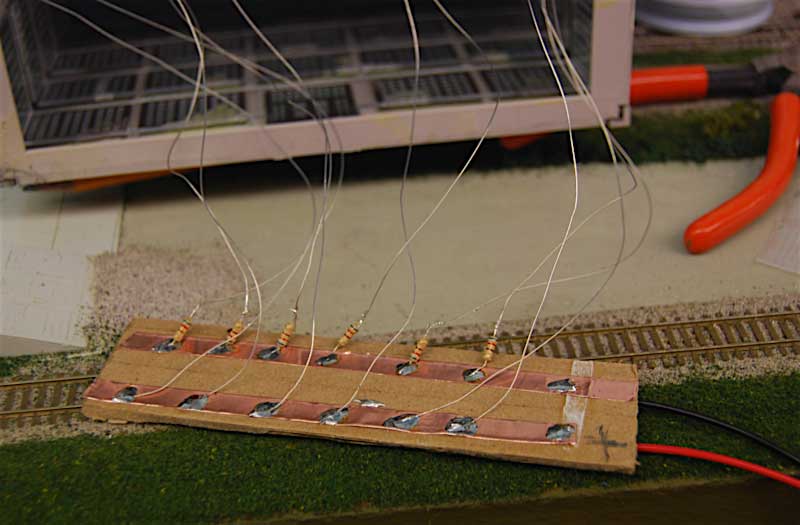
Step 4 - I then tin the wires from the LEDs, being mindful of which wire is the positive (these are light emitting diodes, right, so polarity is important). I land the wires. At the positive bus, the wires attach very easily and quickly. For the resistor side, I use the "Kasper paralllel soldering method", where the two wires are tinned, held parallel, heated simultaneously, then held precisely in place while the solder cools. This technique requires a steady hand, and tinning the wires beforehand is crucial. I'm getting better at it.
Elite Operator™ tip! It doesn't matter if the resistors go before the LEDs or after the LEDs in the circuit. Just sayin'.
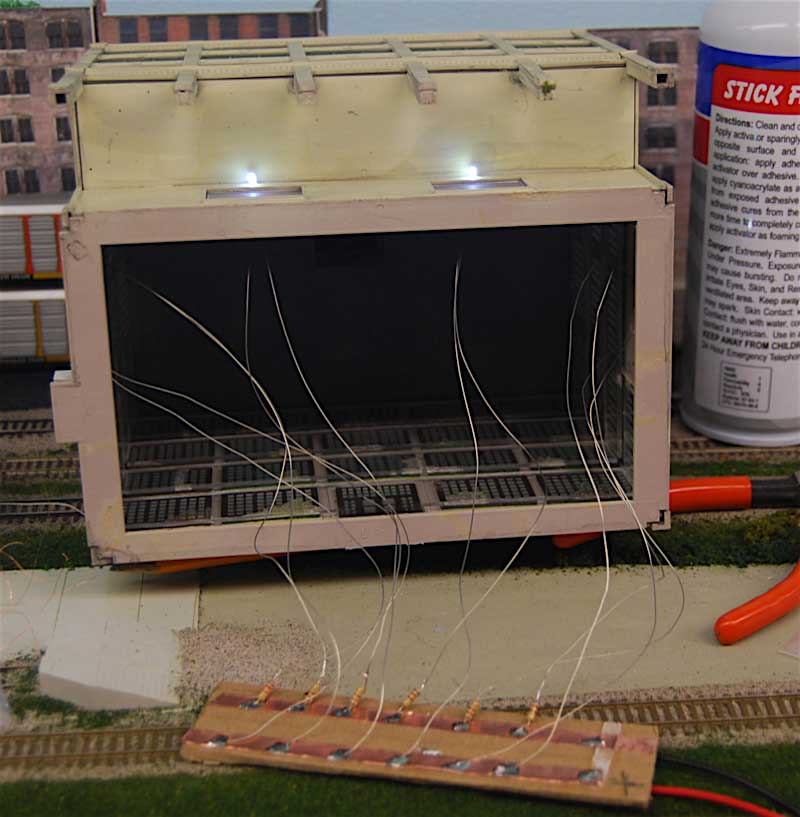
Step 5 - Test the wiring (I have a battery pack with a connecting plug to help with this step.
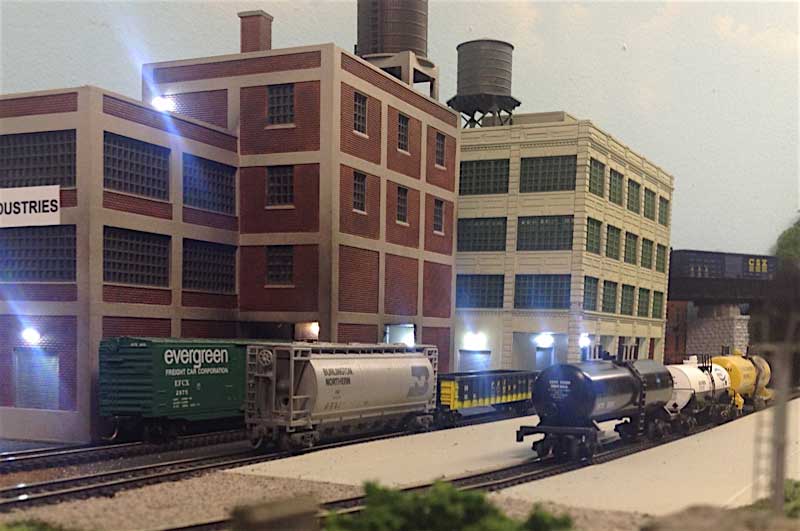
VOILA! Yummy lighting goodness! I think lighting really adds to the scene. These LEDs are cool white - they also sell a "warm white" version that I like a bit better. I may warm these LEDs up a bit with a dab of Tamiya clear tinted paint.
I wanted to add some lighting the ACF Car Repair buildings at East St. Charles.
The lights turned out great and I wanted to share my method for installing the LEDs. It's not rocket science, but you may find a tip or two here.

Step 1 - buy the pre-wired LEDs off eBay (free shipping from China!) and install in the buildings. I just drill a small hole at the location, thread the wires in and secure in place with a tiny dab of super glue. A quick shot of CA accelerator, and the LED is secure.

Step 2 - I make an electrical bus with copper strips that are used for stained glass windows. It has an adhesive backing and takes solder REALLY well. I also use wiring connector plugs (from eBay) that allow me to building these things at the work bench, then plug them into a 12 volt supply from under the layout. Both the positive bus and the ground bus are tinned where I will land the resistors and the wires.

Step 3 - I trim the leads from the resistors and solder into place. The resistor leads going to the bus don't need to be tinned, but I tin the free ends, because it makes the next step a LOT easier. The resistors values have been selected to provide good intensity with a 12 volt supply.

Step 4 - I then tin the wires from the LEDs, being mindful of which wire is the positive (these are light emitting diodes, right, so polarity is important). I land the wires. At the positive bus, the wires attach very easily and quickly. For the resistor side, I use the "Kasper paralllel soldering method", where the two wires are tinned, held parallel, heated simultaneously, then held precisely in place while the solder cools. This technique requires a steady hand, and tinning the wires beforehand is crucial. I'm getting better at it.
Elite Operator™ tip! It doesn't matter if the resistors go before the LEDs or after the LEDs in the circuit. Just sayin'.

Step 5 - Test the wiring (I have a battery pack with a connecting plug to help with this step.

VOILA! Yummy lighting goodness! I think lighting really adds to the scene. These LEDs are cool white - they also sell a "warm white" version that I like a bit better. I may warm these LEDs up a bit with a dab of Tamiya clear tinted paint.
There's no squealing in model railroading!
Jun 16, 2016 Filed in: Ruminations
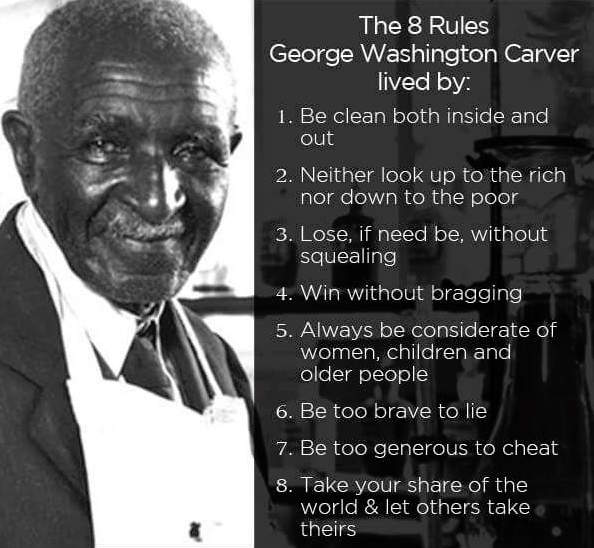
I've always had a fondness for George Washington Carver. You know, the peanut guy.
His story fascinated me as a child, and I've read a couple of biographies that cemented my fascination. He seemed to be a genuine person, and the world needs more genuine people today.
He was born into slavery near Diamond, Missouri. His life is too interesting to recount here, but Wikipedia has a good summary. He studied and taught at Iowa State University, my alma mater, before moving to Tuskegee Institute, In fact, I attended all my math classes in Carver Hall on the ISU campus.
I came across this graphic the other day, and enjoyed thinking about this great man for a while.
Peace, love, and model railroading. And no squealing.
Guest Blog Entry! How to improve cheap eBay trees
Jun 16, 2016 Filed in: Scenery
An acquaintance of mine and good friend of Steve's, NMRA Board Member Kathy Millatt shares her ideas about improving inexpensive trees from eBy. Great info, Kathy! Thanks for sharing.
Zen Mind, Beginner's Mind - applied to model railroading
Jun 14, 2016 Filed in: Ruminations

"In the beginner's mind there are many possibilities, but in the expert's there are few."
So begins one of the most beloved American Zen books, and one I devoured during my quest for enlightenment in the early ‘80s. That was back before I got into model railroading.
Seldom has such a small handful of words provided a teaching as rich as has this famous opening line of Shunryu Suzuki's classic. In a single stroke, the simple sentence cuts through the tendency that students have of getting so close to Zen as to completely miss what it's all about. When recently rereading this passage, I was struck by its application also to model railroading.
“We should not hoard knowledge; we should be free from our knowledge.”
― Shunryu Suzuki, Zen Mind, Beginner's Mind: Informal Talks on Zen Meditation and Practice
When he spoke of "beginner's mind," I think Suzuki Roshi was pointing to that kind of mind that's not already made up. The mind that's just investigating, open to whatever occurs, curious. Seeking, but not with expectation or grasping. Just being there and observing and seeing what occurs. Being ready for whatever experience arises in this moment.
I can think of many times that I have observed this behavior, frequently at layout tours. The new modeler will ask a million questions (What is that? How did you do that? Why is this thing the way it is?), but the old hand will briskly walk around the room, give a curt nod, and be on his way.
Why is that? Does the old hand know all the answers? Does this layout offer nothing new to him? Maybe it’s not his scale, or his gage or his prototype or his era. Does that mean the layout has nothing new to offer him? Or has he moved from “learning by observing” to judging?
It's often the case that when people begin sitting zazen (zen meditation), first they'll be curious about all of these forms we have. Then they'll get kind of interested in practice, and they'll really get into it. They'll start to learn the forms, and then they're experts. They know the forms, and they're looking around: "He didn't do it right...She didn't do it right!" The Form Police. Suzuki Roshi used to say that you should just take care of your own practice; don't concern yourself with other people's practice.
So it is with some people in our hobby. We call them rivet counters. Or elitists - those who know all (or think they know all) but are unwiiling to share or teach others. Those people are maddening because you know that they have SO much to offer, but seem to hoard their knowledge, dishing out wisdom to a select few deemed worthy.
Fortunately, the vast majority of modelers are not like that, and freely share what they have learned about their chosen prototype or area of special expertise. To those people, I say BRAVO!
So please, cultivate your beginner's mind. Be willing to not be an expert. Be willing to not know. Not knowing is nearest. Not knowing is most intimate.
The famous Frank Sinatra burger recipe!
Jun 14, 2016

It's not well known, but Frank Sinatra was a model train fan. He had a large collection of Lionel trains. And evidently he was also a burger fan.
The pull-up resistor
Jun 14, 2016 Filed in: electronics
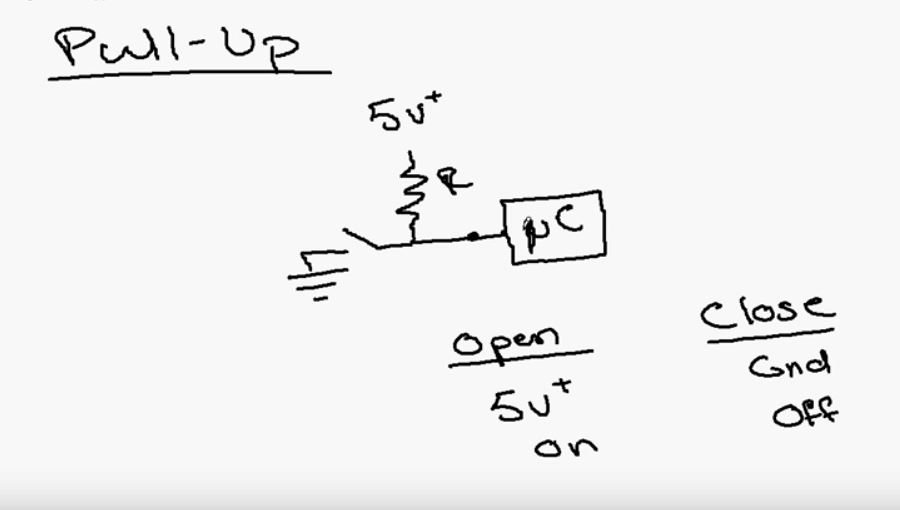
I've been working on some arduino circuits and decided to take a break to learn a bit about pull-up resistors, which are used in a digital circuits to prevent floating conditions when dealing with inputs.
As usual, a quick search on the google provided a ton of information on the subject. Here is a great video that I found on the youtubes:
Who says you need a minimum 6-inch bench depth?
Jun 13, 2016 Filed in: Design | Prototype Research
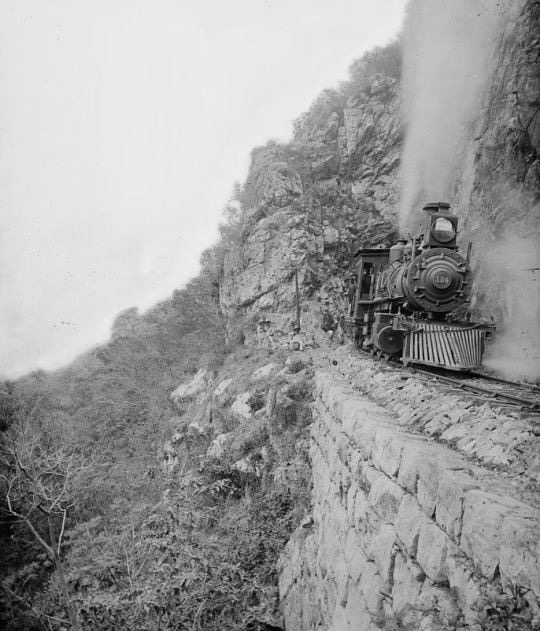
Train on a ledge, exiting Tunnel 8, Temasopo Canyon, Mexico, circa 1880-97/
Every wonder what it's like working on a long layout to-do list?
Jun 10, 2016 Filed in: Ruminations

Yeah, it's kinda like that…
Work Night - St. Charles is ROCKING!
Jun 09, 2016 Filed in: Work Night | Scenery
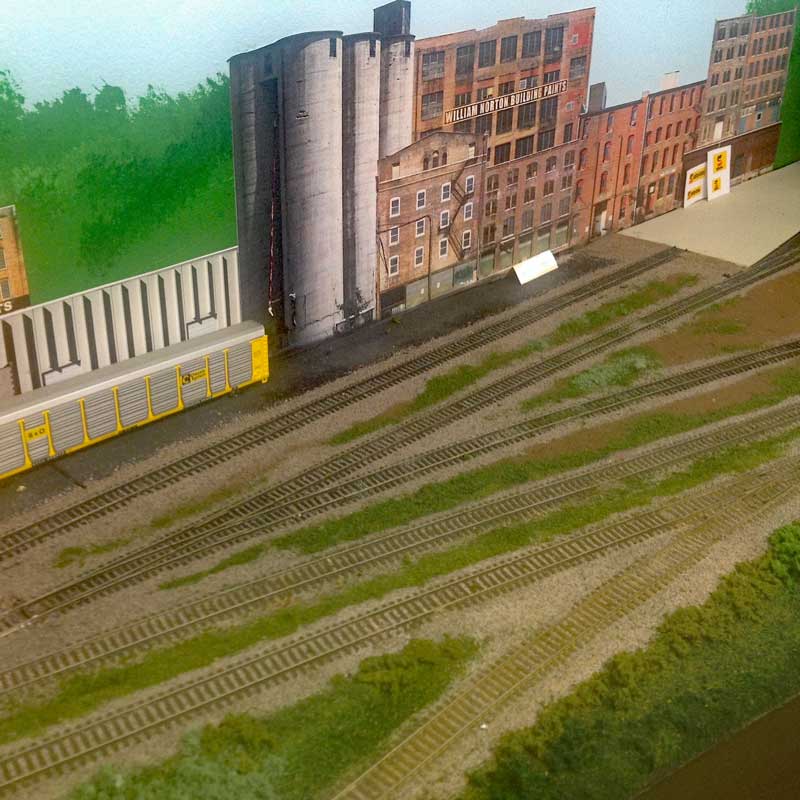
I am SO grateful for friends like Steve and Joe. At tonight's work session, Steve helped toward completing the ballast and base scenery at St. Charles, and Joe tackled the "turnout replacement project from hell" at West Rhineland. Joe hung in there until all the turnouts and track were installed. i marvel at his tenacity and ability to think through a problem and, believe me, those turnouts were a problem. We were trying to retrofit the turnouts without disturbing too much of the ballasted and scenicked track, when we probably should have just ripped out the entire area and started over.
Thanks Joe and Steve for your help tonight!
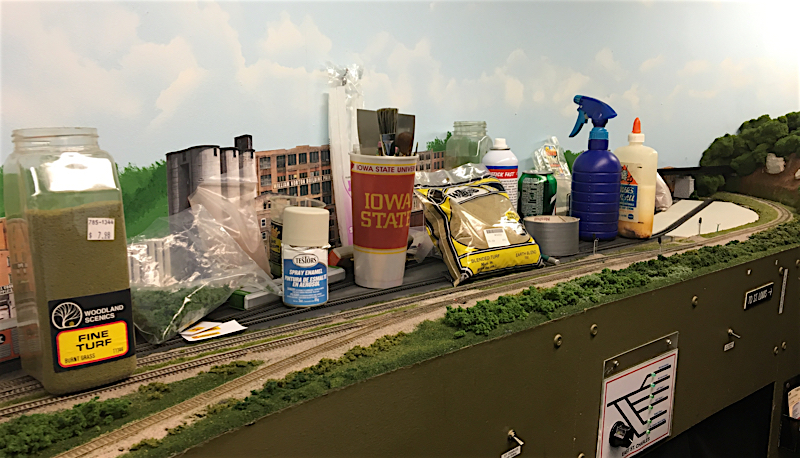
Scenery work really makes a mess of the layout. I will soon put all the scenery materials away and start concentrating on cleaning the room and the track in anticipation of the layout tours and operating sessions for the N-Scale Convention coming up in late-June.
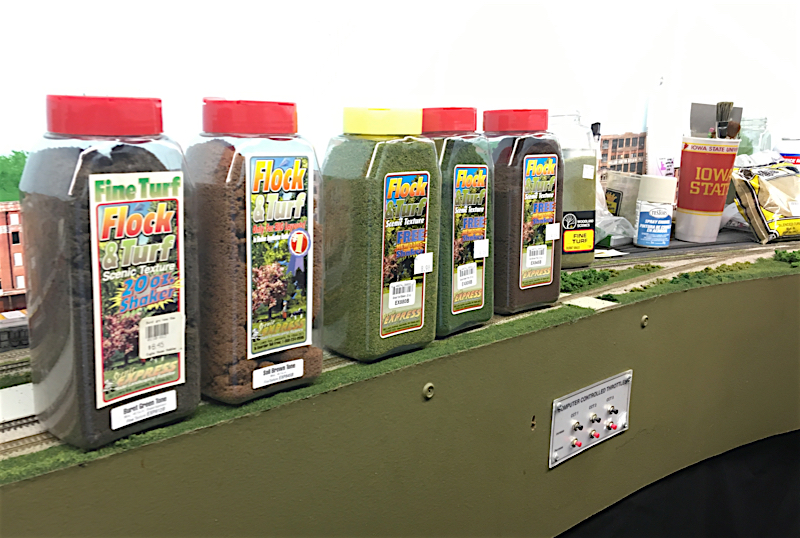
Scenery materials aren't cheap, but they seem to go a long way on the layout.
New Scenery at St. Charles!
Jun 07, 2016 Filed in: Scenery | Work Night
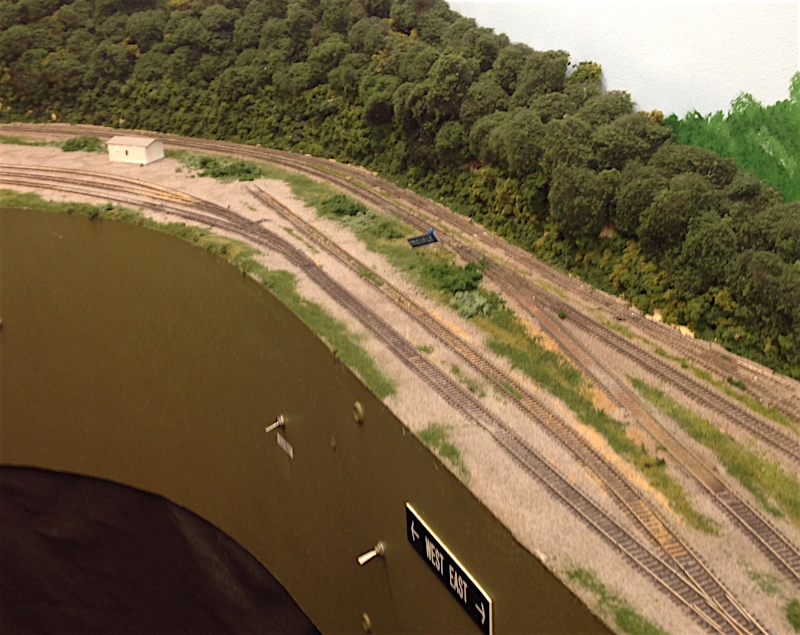
Phase I scenery - ballast and basic landforms. We'll come over this with additional scenic elements and weathering
Last night was another great work session with my scenery gurus, Steve and Dan. We worked at the St. Charles area, ballasting track at Tavern Rock, improving the pig ramp area, and continuing work on the pavement at Safety Kleen and the autoramp.
The new scenery looks great, but along with the improvement comes a maintenance headache – frozen turnouts. Ballast and glue doesn’t mix well with moving parts, and each turnout needs to be “exercised” while the ballast dries to ensure that movement is free and non-binding. Often, we will need to spray water into the turnout points to free up imbedded ballast. It’s not a big deal, unless you forget to check them until just before an operating session, then PANIC!
Special thanks to Steve and Dan for the help, and especially to Dan for the lively Bob Dylan impressions!

I also added a TON of additional trees to the visual divider between St, Charles and Lick/Boonville. It looks GOOD!
Here is an imitation of Bob Dylan almost as good as Dan's:
Awesome Rainfan Mapping App
Jun 05, 2016 Filed in: Railfanning | Prototype Research
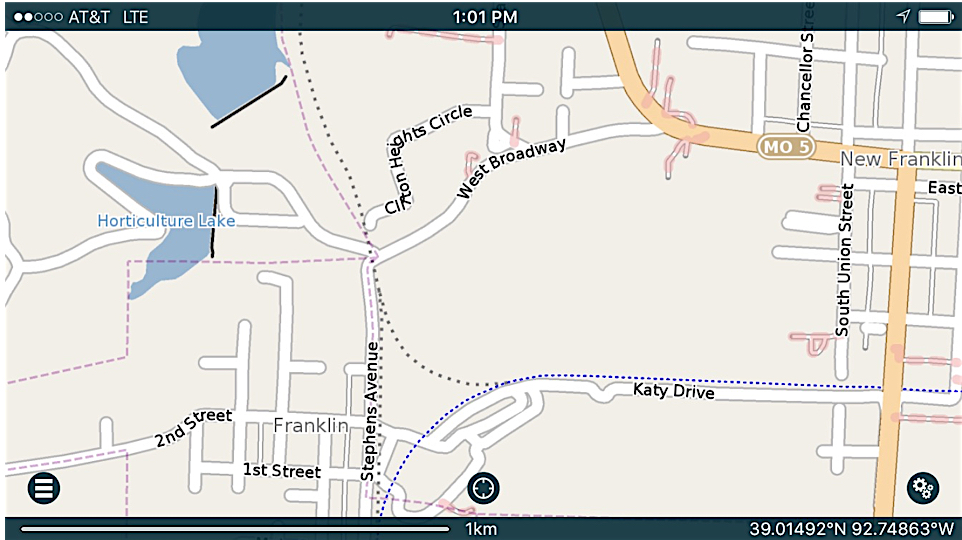
Here is a screen shot of Franklin, Missouri. You can see the existing Katy Trail, and the old track (long gone) of the MKT Hannibal Branch and wye.
I spent a fun afternoon with Joe and Steve, my two smart train buddies, rail fanning along the St. Joe Sub of the BNSF. Both Joe and Steve know this stretch of track like the backs of their hands, and Steve knows a ton about the history of the other railroad that used to be present in this area. We caught several trains running in both directions and generally had a great time (except where Joe almost got us all killed passing a slow-moving farm vehicle, but that is a story for another time).
During the trip, Steve showed me a great app for the smart phone. Pocket Earth Pro is a mapping app, similar to Apple Maps or Google maps. There are two benefits of Pocket Earth Pro over the traditional map tracker programs that are of particular interest to the foamer:
- You can download the map data and still use the program when you don't have a strong data signal (important for those "way out in the county" rail fan trips, and
- It shows the old, and abandoned rail lines
As a test, I looked at Paola, to see if the old MKT Osage Division tracks were included. They were! And those tracks have been abandoned since 1958! I'm planning a "walk in the woods session" for the Osage Division and this app will be crucial to planning that trip.
So if you are a rail fan, You need to give Pocket Earth Pro a look. The intro version is free, and the "PRO" version is $4.99. Worth every penny!
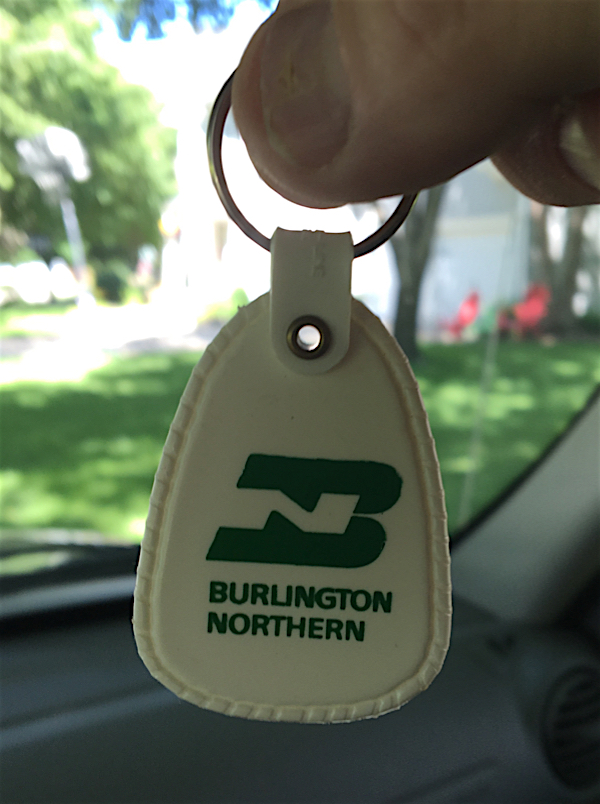
Sacred Talisman of Good Train Hunting, carried along on all rail fan trips! It has never let us down!
Alaska Railroad Cabooses on the Katy
Jun 04, 2016 Filed in: Prototype Research

I don't know much about them, but in the 1980', the MKT leased some Alaska cabooses. Here are a couple of pics.
It sure would have been crazy to see one of these hacks on the tail end of a Katy train in Missouri.
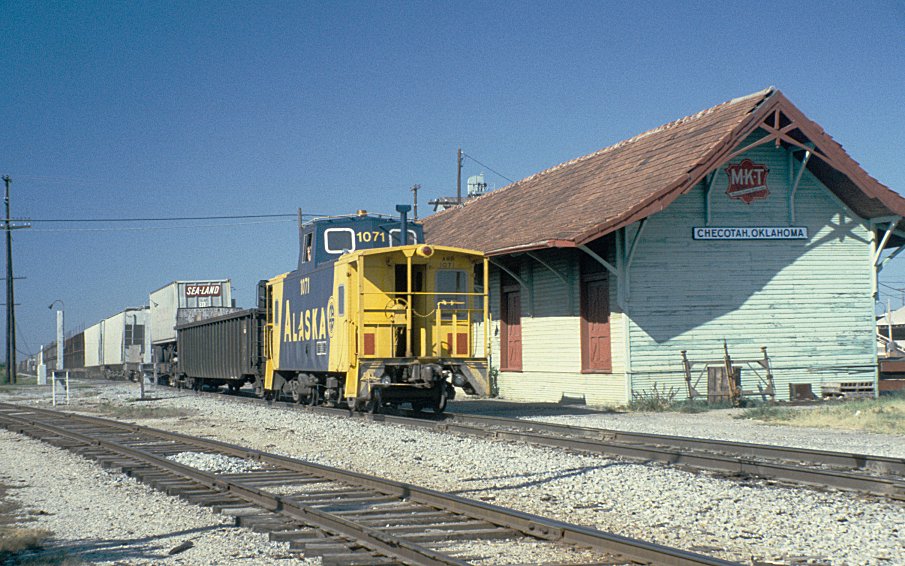
Master of Disguise - a work in progress

I've been working on obscuring the opening at St. Charles, where the track punches through the wall into staging. It's a work in progress, but the effect is already much better than the gaping hole that was there before. I need to replace the N&W train on the bridge and place more ground vegetation, but it's getting there.
New turnouts for Bunge-holio
Jun 01, 2016 Filed in: Track
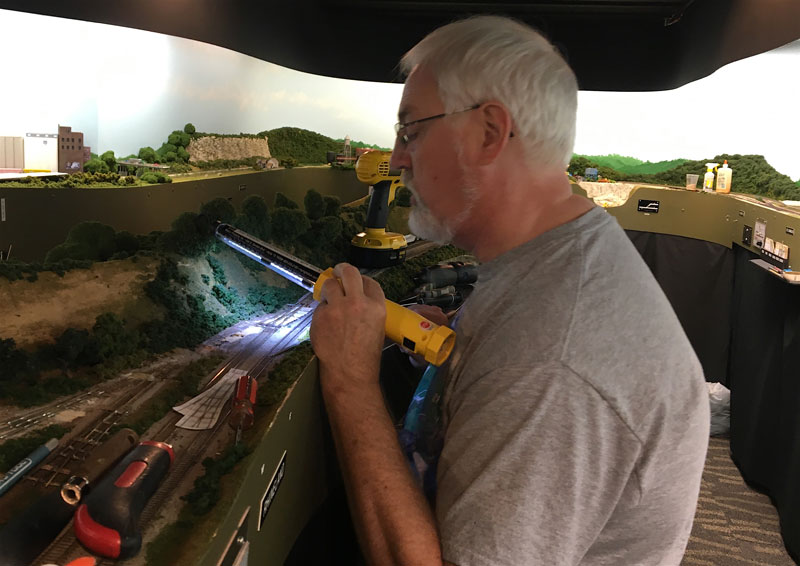
Joe attempts some layout magic by passing the "Wand-o-suck-reduction" over the turnouts at West Rhineland
Soon, the Bunge Elevator and other West Rhineland industries will benefit from the sweet nirvana know as a Kasper MKVII, Rev 2 turnout retrofit!
I originally installed Peco turnouts at this location (and many others around the layout), and for years they worked fine, particularly during the DC-powered Chubb-o-matic era (Computer Cab Control using Bruce Chubb's great Computer/Model Railroad Interface).
But, since the conversion to DCC, I wasn't happy with the performance of the turnouts - too often, the locomotives died on the unpowered frog. Plus, the turnouts were hand thrown, and my personal preference is for turnout operation using a fascia-mounted toggle or a diode matrix rotary knob.
Joe has come to my rescue with some sweet Kasper MKVII, Rev 2 #6 turnouts! And he has graciously offered to help me install them. And by "help me", I mean that he kicks me out of the layout room while he installs them himself. He say's that my "help" just slows him down (it's true…).
So, the next time your run on the Mighty MKT, do yourself a favor and take the St. Charles local. Then you will get to experience the silky operation over the West Rhineland track and turnouts!
Shake what yer mama gave ya
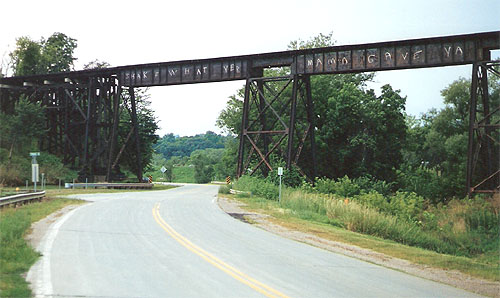
I grew up in the country west of Council Bluffs, Iowa. Our house was located off old Highway 6, and very near the old Rock Island line that ran from C.B. north to Avoca and on west to Des Moines and Chicago. The line was fairly active in the late-‘60s, but traffic petered out in the ‘70s. The Rock was shut down in 1980.
In 1984 the old Rock Island line out of Council Bluffs became part of the Iowa Interstate (IAIS) Railroad. For years, it ran a couple freight trains a day on the old Rock Track, but these days traffic is increasing with the addition of intermodal (!) traffic on this old and historic track.
A distinctive landmark on the old Rock Island track was the single track bridge crossing Old Highway 6 (McPherson Ave) and Little Mosquito Creek, just west out of Council Bluffs. This deck plate girder bridge was built in 1901, and has a total length of 320 ft. The longest span is 70 ft.
I passed under that bridge a thousand times when I was growing up. When I was in junior high, a friend challenged me to climb up and walk across the bridge, but I was too afraid to do it. Somebody had been up there, though, because the most distinctive feature of the bridge was the graffiti on the west side of the bridge, saying “SHAKE WHAT YER MAMA GAVE YA” in shaky letters. Every time I walked, or jogged, or biked, or drove under that bridge I tried to imagine that tag artist leaning over the tracks, writing those letters upside down! Yikes!
Several years ago, my parents moved to a new house, up the hill with a great view of the Mosquito Creek valley, the Iowa Interstate tracks and the bridge. Whenever I visit, I listen for the sound of the trains crossing the bridge. It sees a lot of action these days as the IAIS traffic continues to grow.
Alas, the graffiti has been painted over as part of a bridge approach upgrade project in 2014. But I still adhere to the advice that tag artist gave me those many years ago, and “shake what my mama gave me” as often as I can!.
Here is a link to more information at bridgehunter.com
